User Support in Telecom: Considerations for Building a Relevant Contact Center Solution
© 2022 Tanmaya Gaur, et al. This is an open-access article distributed under the terms of the Creative Commons Attribution License, which permits unrestricted use, distribution, and reproduction in any medium, provided the original author and source are credited.
Abstract
Contact Center solutions offer technology capabilities that enable customers of an organization to contact the organization’s help desk or vice versa (for an organization to reach out to its customers customer) utilizing interfaces like voice calls, text, messaging etc. Contact center technologies help companies fulfill their customer service obligations and are often also used by organizations to enable creation new sales opportunities. Modern contact center solutions try to personalize and contextualize the customer experience provided instead of keeping it static across all its users. These apply in very specific ways to telecom organizations who traditionally have had bias towards voice call-based support methods. This document explores the various aspects and considerations when building a modern contact center for a telecom organization
Introduction
Contact centers allow organizations to connect with their customers. A repeatedly encountered confusion is between contact center and a call center but the two differ as call centers refers to customer support centers that use primarily calling (voice) to service customer calls. In a modern digital first world, contact centers enable communication methods and capabilities beyond just traditional calling. Contact centers have moved this voice only capabilities to now include deeper integrations with various traditional messaging, instant messaging (app based) and social media platforms. This document will touch upon the multiple technology choices and considerations when setting up a contact center. The choices range from determining the interfaces available for the organization’s customers, the level of personalization needs, the actual routing stack including technologies like bots and IVR, as well as the client-side technologies used by the care employees to assist the customer. The document will also call out areas where traditional choices have been upended by recent advancements in AI technology.
Considerations
There are few important considerations when implementing a contact center. This section will focus on establishing up a high- level logical pattern which can be subsequently used to go over considerations that apply to the various tiers of the pattern. These choices and their impacts need to be contemplated to decide what will work best for an organization’s use-case. It is always important to understand the specificities of organization’s use-case and then determine the best solution.
The Logical Stack
Let us first talk align on a high-level logical (refer Figure: 1) contact center flow which we can subsequently break down into various logical sub-modules. These sub-modules come together to provide the overall solution. This breakdown will help get through the rest of the document in a more structured fashion as the paper will discuss through each of these sub-modules one by one.
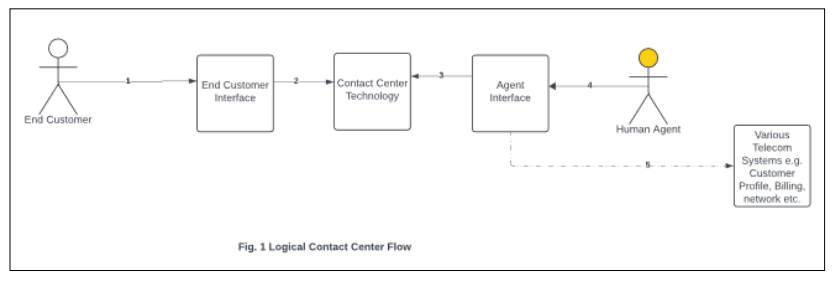
End Customer
This refers to existing or prospect customers of an organization. Existing customers could be individuals or organizations that have purchased goods, services, or products from a business. Prospect customers on the other hand are customers that are interested in making a purchase or are a target audience the organization is trying to attract.
End Customer Interface
This refers to user interfaces that allows Customers to connect with the organization ( arrow 1). A traditional contact center stack could consist of multiple avenues for the end customer to contact the organization. At times, different interfaces may be used to support different transactions. A transaction could refer to various activities the organization needs to support which could range between support, service, sales, marketing etc. There are also other variations to consider, e.g. different contact styles like inbound (customer reaching out to organization) and outbound (organization reaching out to customer) contacts which may use different interfaces. Also, these contacts can range from using traditional voice calls to modern messaging and social media platforms based on the organization type, needs, customer demographic etc. These interfaces need to support all types of customers without bias e.g. there will be accessibility needs that need to be solutioned in an organization’s customer interfaces.
Core Contact Center Technology OR contact Center Exchange This is the underlying contact center software which includes systems like the Exchange, Routing and Contact Distribution software. There are various accessibility aspects that need to be solutioned in the contact center technology, e.g. for a voice end customer interface, the core Contact center stack will be the one to ensure use of TTY/TDD systems to assist deaf or hard of hearing customers during voice contacts. Most modern contact center solutions include automation and containment capabilities like Interactive Voice Response or Chatbot capabilities. This tier is also the one to make routing decisions. This is another area where most modern contact centers use a combination of customer profile, call analytics, IVR, chatbot etc. to make a more informed routing decision. Contact Center may also include a workforce management aspect, especially in the case of larger organizations.
Agent Interface
The contact center will route contacts to agents who use a Customer Relationship or Service Management interface to assist with these contacts. These capabilities are often exposed to agents via a UI Experience built using web or native technologies. A modern CRM solution needs to solve for security, fraud and scalability to meet the demands of a growing organization. The agent interface uses patterns like RESTful API(s) to integrate with Backend Systems to retrieve and display data to agents enabling support capabilities. There are also data compliance requirements which this Tier needs to play a huge role in e.g. FCC, CCPA etc.
This document will use the logical breakdown listed above and depicted in Figure1 to discuss implementation aspects specific to each sub-module. It is important to highlight that real world scenarios are often far more complex and there may be additional considerations based on the specific use-cases that are being solutioned. As an example, there are variety of customer or contact types applicable to organizations which often complicate implementations. Another example is that the logical implementation we talked through demonstrates an inbound contact initiated by the customer. Real world contacts however may also be outbound and initiated by the organization. There may also be call transfer scenarios between agents where contact information will need to be persisted to provide optimal and relevant experience. A modern real-world solution often mixes IVR, bots and humans in a single contact but while wanting to retain continuity of customer experience. There is also the added complexity optimizing the cost to serve and ensuring being able to scale the organization’s contact center while keeping costs relatively flatter.
Subsequent section (section 3) will go over the logical breakdown one by one and dive deeper into the specific sub-modules. Prior to that, section 2.2 will hit on some other considerations for a CRM build-out which also need to be considered but are out of scope for this paper.
Miscellaneous CRM Concerns not covered in this paper Scalability: A contact center stack needs to be able to scale to meet the demands of the user-base.
Security: Everyone is familiar with the critical role telecom plays and the increasing amount of data breaches, it is very important to build a call center with security in mind.
Compliance: There are multiple data and privacy compliance laws across B2B and B2C landscape. These need to be supported by the organization.
Infrastructure: The concerns range from choice of infrastructure, where it is hosted and managed, and associated costs.
Analytics: Call center software needs to collect and store myriads of information that is subsequently put to variety of use. E.g. this information may be used to improve your organization's performance.
Integration with Organization’s domains & data: Contact center need to integrate with other domains within and outside the organization. Most modern integrations use API(s). There may be different variants depending on how the infrastructure is hosted.
Cost: Considering the cost is a very important factor regarding budget and quality.
Reporting: Robust reporting provides visibility into contact center performance and trends over time. These insights could then be used to optimize the contact center operation and costs.
Internationalization: Based on customer base, multiple languages may need to be supported. There may be need for tooling to enable such support across the various contact center aspects.
AI-Driven Efficiency: AI is upending how contact centers operate. There is planning to create a separate paper which dives into this specific topic.
The Buy v/s Build conundrum
As mentioned before, there are multiple players which provide solutions ranging from end-to-end contact center capabilities or specific sub-modules like CRM UIs for organizations to integrate with . Gartner’s magic quadrant (figure: 7) is a great way for organizations to consider their options. Most of these CRM systems provide plug and play capabilities and allow the entire stack to be used or specific sub-modules if an organization wants to use a hybrid approach.
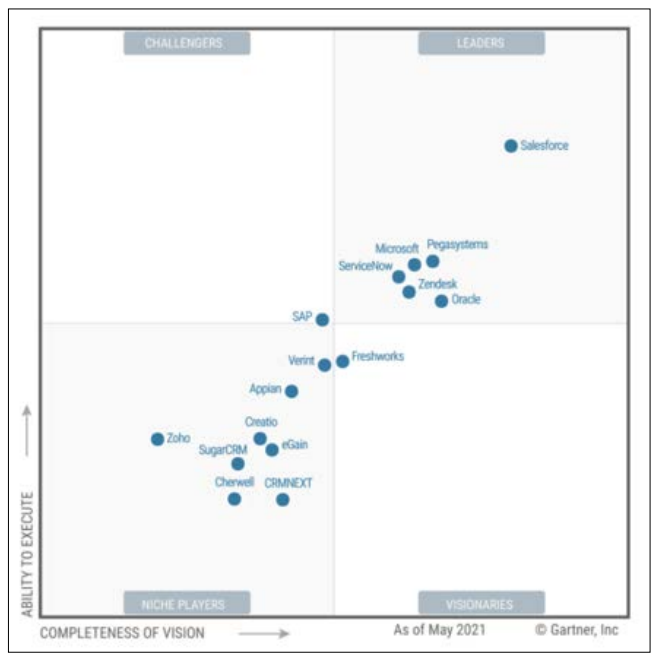
Figure 1: Gartner Magic Quadrant 2021
Certain vendors focus on specific aspects of the interaction. As an example, live person is a well-known platform that champions conversational AI but do not have similar capabilities for voice- based interfaces. Large organizations that tend to us live person use it to augment their existing voice capabilities. Khoros is another such product which puts a lot more focus on social media, AI and automation.
Contact center KPI(s)
KPI(s) or key performance indicators are useful to monitor and gauge health of the contact center as well as be aware of on-going issues. Key contact center KPI(s) for a telecom organization’s contact center are listed below. Please note that this list touches the important KPI(s) but is not exhaustive.
Call Resolution or Mean Time to Resolution (MTTR): is a customer service metric that measures how long it takes to resolve a customer issue. It's mostly calculated by dividing the total time spent (in hours or days) by the number of cases resolved. Depending on workforce setup, this may be captured at individual as well at a team level.
Average Handle Time: This is the average of the handle time of a customer’s call, which is important for monitoring agent performance. This differs from Call Resolution time as that KPI may include additional post call activities done by the agent to resolve the issue.
Net promoter score (NPS): is a metric for measuring customer satisfaction and loyalty towards the Brand. This is often measured by asking the customers to provide feedback on how likely they are to recommend the organization.
CSAT Scores: While this sounds like NPS, this differs in the fact that while NPS looks at customer’s loyalty towards the brand, CSAT is often evaluated for specific products and services.
Cost per call: A financial metric that measures the amount of money it takes to handle an individual call.
First Call Resolution: a metric that measures if the agent was able to resolve customer issue on the first contact. This indicator can apply to both productivity and financials as it can help businesses improve customer satisfaction as well as reduce operational costs. First Response Time: is the time between when an agent receives a request for support and when they start communicating with the customer
Call Wait Time: is often used to capture the period the client spends in the call queue before linking to the operator.
End Customer
A modern telecom organization often support multiple products and services across different customer segments. Such needs drive organizations to utilize multiple end customer interfaces, often driven based on the nature of specific product or services involved, and the customer segment or demographic being served.
One important consideration is the variation in customer segments when B2B versus B2C customer types. Such customer type variations often have far-reaching impacts on the implementation aspects of the interface. As an example, customer authentication for a B2B Customer may use a federated IAM solution while A B2C user will likely be utilizing the organization’s IAM or popular oAuth services offered by providers like Facebook, Google etc. if the organization supports them. Compliance, Security needs are also different between these two customer types.
Another important variation that impacts implementation is the specific product or service offering of the organization. A modern telecom organization offers variety of plans, devices and other services which necessitate different end user interfaces or approaches to service. Example of these product variations for telecom could be hard-good devices or accessories, soft good plans and add on services like data packs and protection plans or even variations in financing like purchase with full down payment versus purchase using loans. An example to make sense of such variations is the telecom plan offered could include voice and data or be a data only plan, voice plans often come associated with a MSISDN which could be used for communication and to support other service needs. A data/ internet only plan often does not have a MSISDN associated and hence the organization needs to fall back on technologies like e-Mails and messaging identity for communication and service needs.
Another variation is subtle differences between prospects versus existing customers. An equally important variation is driven by the nature of contact being outbound or inbound.
It is key for an organization building a contact center to understand the various end customers and to assess impacts when deciding on the right solutions and patterns to use.
End Customer Interfaces
A typical telecom organization supports multiple products and services across different customer segments. There are needs to utilize multiple end customer interface solutions based on nature of business, product or service being offered and the customer segment or demographic being served. These needs may be driven by the capabilities of an interface to be better optimized for a particular need, the costs or financials involved, or by the ability to meet compliance or customer satisfaction targets. Some interfaces may also be necessary to stay relevant culturally or financially by being able to target specific markets.
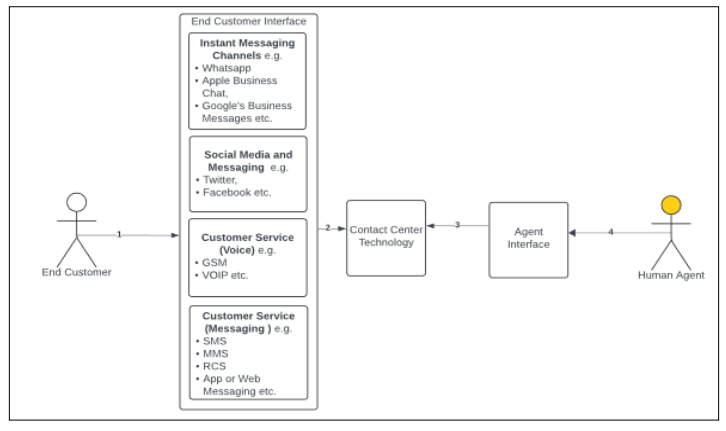
Figure 2: End Customer Interfaces
Traditional interfaces for end customers have long been to use voice channels where a customer places a phone call to a customer support line for assistance. Many new interfaces are starting to be supported over time to include capabilities to connect with customers using interfaces like instant messaging and social media. Telecom organizations already support native messaging capabilities like SMS, MMS etc. but instant messaging channels like WhatsApp or OS specific messaging capabilities are catching Apple business chat for example is a messaging platform which is part of the apple ecosystem and is widely used by a large section of users and is often supported. This modern channel allows users to communicate with businesses using native iMessage App capabilities on apple devices.
Majority of contact center solutions nowadays provide interface capabilities into social media platforms to meet customers where are at and want to connect. This includes presence of support on social apps like face-book and twitter. It has become important to support these interfaces as a high percentage of consumers now-days make purchase decisions based on these mediums e.g. Facebook. When a company supports these social media channels, it is not enough to just create an account and claim presence, especially when this new account will become a hotbed for users to voice issues and problems. It is important to build and solve the entire support lifecycle required for this interface.
Consider this: 47% of those surveyed by Edison Research said that Facebook, of all the social networks, had the greatest impact on their purchase behavior. A Facebook interface plays a big part in that. Forcing users to search for a customer service number on Facebook, or any phone number for that matter, doesn’t make for a positive impact.
Core Contact Center Technology
A key aspect of any contact center solution is the core underlying software stack. Telecom companies have historically invested in building own home-grown solutions given proficiency in creating voice-based solutions. With the advent of modern channels however, the approach to building out contact centers often ends up being a hybrid solution space.
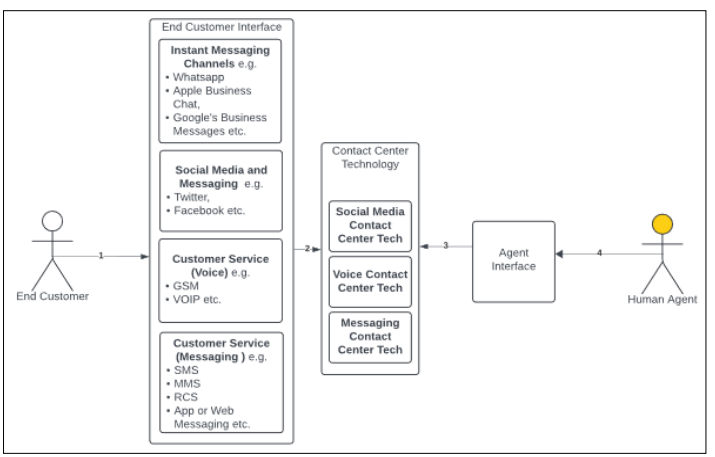
Figure 3: Contact Center Technology
The modern Contact Center Technology stack could be built up of multiple different tech stacks handling Contacts from the different interfaces. There may be different solutions to handle voice, messaging and social media integrations. There are SaaS solution providers like Nuance, Salesforce, ASAPP which offers platforms which handle all these interfaces. There are also niche players like live person that focus on specific interfaces. The solution choice depends on the needs of the organization.
This tier may also include telecom centric capabilities and integrations. An example would be where the telecom companies can validate capabilities like the STIR/SHAKEN headers for securely validating the calling device. This is also the tier that incorporates automation capabilities like IVR and chatbots. Containment is often defined as the percentage of inbound calls completely handled by the IVR or chatbots, divided by the number of total incoming calls. This is a crucial aspect to consider for your chatbot and IVR implementation as containment is a metric used in call centers to measure the effectiveness of self-service systems like chatbots and Interactive Voice Response (IVR) systems. Modern AI advancements have allowed companies to put more capabilities to increase containment further. While this was a KPI traditionally applied to Voice channels, advent of chat-bots in Messaging and other channels have played a bigger part towards this increase, especially when backed by modern AI capabilities.
This tier may at times also contain workforce management capabilities, especially for larger enterprises. These are the processes used to optimize productivity and reduce risk. This includes day to day items like scheduling and payroll integrations but could also include capabilities like call volume forecasting which helps with projecting staffing needs, workforce tracking and productivity quantification, team management as well as reporting and analytics of key contact center KPI(s).
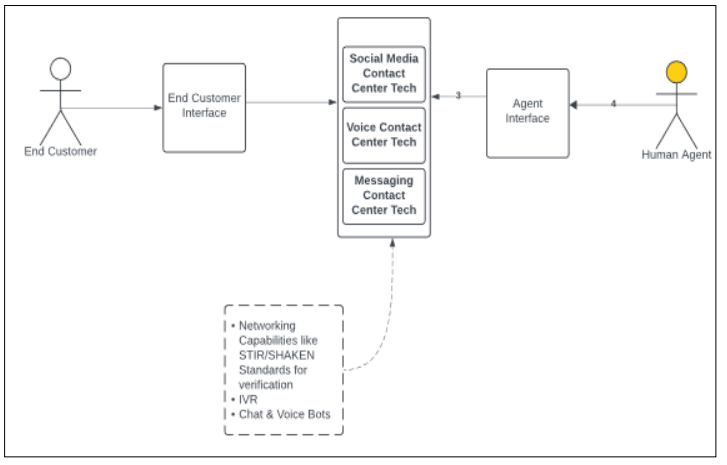
Figure 4: Additional Aspects of Contact Center Technology
Another upcoming aspect of contact centers enabling multi- modal interactions. Multimodal capabilities enable customers to communicate with the organization to seamlessly and using multiple modes of interaction: voice, visual, text, etc. This could include switching a conversation between a chatbot and a voice channel without losing context or could allow a customer to use two interaction modes side by side with interactivity and awareness between the channels helping keep the interaction contextual.
Agent Interface
The agent interface is often the CRM/CSM Capabilities that are presented to support agents. There are quite a few few critical responsibilities that are needed to be solved. This Tier must integrate with the core contact center and at times the telephony hardware to be able to present the incoming interaction to the agent. At times, this interaction also involves fetching call meta data and details captured by the IVR. This tier also has integrated with the backend systems to pull up information required for the agent to assist the caller. The requirements to build out this interface breaks down into functional and non-functional aspects just like any experience development factory. The functional aspects determine how best to present and lay out all the data for the agent to best perform the job of assisting the customer. The non-functional aspects deal with concerns like security, performance, scalability and stability of systems and must solve for compliance aspects like PII, CPNI, PCI etc. The accessibility needs for customer interfaces also apply to agent interfaces.
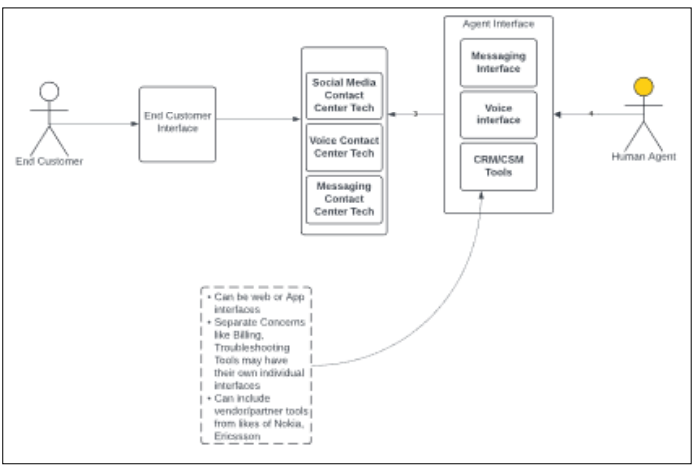
Figure 5: Agent Interface Concerns
These systems can be referring to a single system or multiple isolated systems coming together to help solve this, Tier. A large organization needs a lot of capabilities which building in a single monolithic solution often gets unmaintainable over time. There are some opportunities with patterns like micro-frontends but ultimately, the decision taken is based on the various factors that apply to the organization.
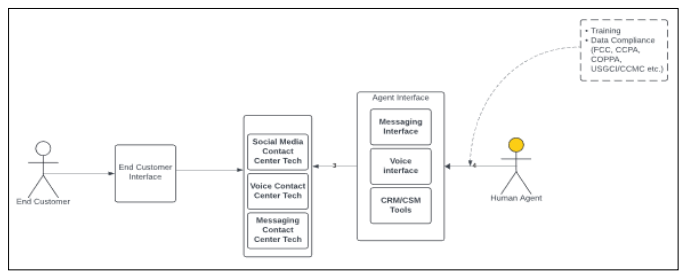
Figure 6: Other Misc Considerations
In addition to the already stated compliance aspects when building a CRM, there is the need to ensure the overall system continues to prioritize usability of the agent’s experience. At scale, there are needs to be ability to train the agents when launching new experiences (or when onboarding new agents), having a maintainable release process and cadence as well as there is the need to ensure a viable testing and analytics strategy to establish how changes impact agent behavior as well as overall KPIs.
Conclusion
Establishing a contact center for a telecom organization requires the organization to understand aspects like nature of its product and services, its financial structures and needs like security and compliance etc. There are additional aspects of the end customer being targeted, the cost to serve and various elements of the intended customer journey that need to be well understood. Understanding these dynamics is critical to building out a successful solution.
Modern contact centers go beyond traditional call center solution, and include multi-faceted customer interaction avenues, personalization and contextualization. It is crucial to be aware of latest technology trends with AI and ML technology like Recommendation systems when building the solution. These technologies could be used to build solutions that range from journey optimization to full automation and often containment. At the current rate of evolution in this space, these technologies will prove pivotal to shaping future landscape of customer support across industries.
There also is the need to be constantly aware of the various solutions out in the market. There is always a build v/s buy conversation to be had given the multiple software as a service offering which could be a good fit for an organization.
References
- Nuance conversational CRM https://www.nuance.com/index.html.
- Contact Center v/s call center https://www.cisco.com/c/en/us/solutions/collaboration/what-is-a-contact-center.html#~call-center-or-contact-center.
- What is CRM https://www.salesforce.com/eu/crm/what-is-crm/.
- Interactive Voice Response https://www.ttec.com/glossary/interactive-voice-response.
- Elevated role of contact center https://servion.com/lp-whitepaper-the-new-customer-experience-and-the-elevated-role-of-the-contact-center/.
- STIR/SHAKEN https://t-mobile.com/news/network/stir-shaken-all-networks.
- Customer Service channel usage highlights https://www.com/blogs/15-01-22-customer_service_channel_usage_highlights_the_importance_of_good_self_service/.
- Gartner CRM Index https://zendesk.com/blog/gartner-magic-quadrant-crm/

